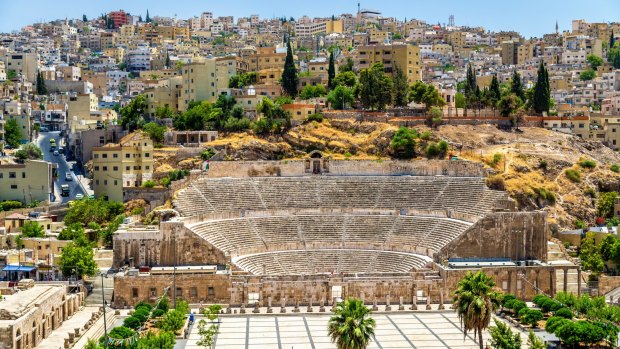This was published 6 years ago
Amman, Jordan: Where to find some of the world's best Roman ruins, outside Rome

The Roman theatre in Amman.Credit: Shutterstock
What have the Romans ever done for us? That's the classic refrain from the Monty Python film Life of Brian, and you can't help but mumble it to yourself as your pick your way through the ruins of Jerash in central Jordan.
What have the Romans ever done for us? Well, it appears in this ancient settlement they've built roads – roads that have survived millennia. They've built public baths too, some of the first of their kind. They've built temples. They've built theatres. They've built markets. They've built triumphal arches.
Though many of those structures are these days mere shadows of their former selves, dusty ruins baking in the Jordanian sun, you can still very easily picture the true glory of Jerash, the bustle of the colonnaded main street, the crowds cheering at the hippodrome, the hushed silence during a performance at the theatre.
The Roman Empire forever changed the country we now know as Jordan. Though the modern-day nation is famous among tourists more for the legacy of the Nabateans, who sculpted the city of Petra out of living rock, it's the marauders from the north who perhaps left the most lasting legacy, who ruled for four centuries, who built roads and aqueducts, who brought wealth and prosperity, and who left behind a series of settlements that remain some of the best-preserved Roman ruins in the world.
Jerash is the obvious highlight. This was one of the greatest provincial cities in the Roman Empire, an area that is now a series of extremely well-preserved ruins set amid the cacophony of a modern city. Walk through Hadrian's Arch, a structure built to welcome Emperor Hadrian in 129 AD, and you can see cars on the highway in your peripheral vision, spot a shop advertising toasted cheese sandwiches just across the road. Clearly, things have changed.
The further you wander into the ruined city, however, the easier it is to picture Jerash the way it once was. The hippodrome, traditional site of chariot races, has been partially restored. The forum is a magnificent paved plaza enclosed by 160 original Ionic columns. The Temple of Artemis still towers over the extended city, a tribute to the engineering skill of the ancient settlers from the north.
It was 63 BC when those conquerors first arrived in Jordan, when they seized the Greek settlement of Gadara at the point where Jordan now meets Syria and Israel. Parts of that city still stand sentinel, too, over this vital border. There's a colonnaded main road, still with the original paving stones. There's a 3000-seat theatre with a spectacular view, something to take in these days and ponder as Jordanian military helicopters hover above, surveying the territory. ("We're lucky to have such nice neighbours," mumbles Ogla, my guide.) There's an aqueduct, too, that runs 95 kilometres underground, the longest known from ancient times.
The Roman influence doesn't stop here at Gadara, either. Even those famous ruins of Petra show signs of occupation, if you know where to look. The main road that runs through that famous settlement was built by the Romans in the 1st century AD – today you can still see ruts carved into the stone pavings by chariot wheels; see original columns lining the arrow-straight path; see the ruins of temples; see the influence of Roman architecture on the rock-hewn tombs that were carved after the Roman Empire subsumed the area created by the Nabateans.
And, of course, the Romans once dominated what is now the Jordanian capital, Amman. It was called Philadelphia back then, a Greek settlement that was rapidly reshaped in the new rulers' image, and today still boasts that legacy amid a modern-day metropolis.
The crowning glory is probably the Roman theatre, an open-air, 6000-seat venue that looks up to the Temple of Hercules perched on a hill above. The theatre is spectacularly well preserved, the sort of place where you can stand on the stage and pretend you're an ancient performer, or sit high in the stands and imagine the performances that once took place.
Modern-day Amman encroaches from all sides. The street nearby is a snarl of traffic; the hillsides are crowded with grey-brick homes. But it's not hard to see what the Romans have done.
TRIP NOTES
MORE
FLY
Emirates has regular flights between Australia and Dubai, with connections to Amman. See emirates.com
TOUR
On The Go's Totally Jordan tour is an eight-day itinerary that takes in most of Jordan's Roman historical sites, including Petra and Jerash. Tours start from $2495 per person, and include accommodation, transfers, guides, and some meals. See onthegotours.com
Ben Groundwater travelled as a guest of On The Go Tours.
Sign up for the Traveller Deals newsletter
Get exclusive travel deals delivered straight to your inbox. Sign up now.